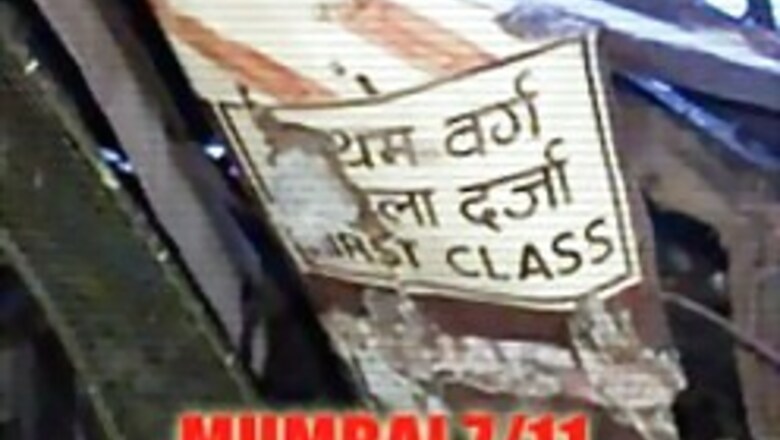
views
New Delhi: Eight days after the Mumbai serial blasts, the investigation trail seem to be dotted with confusion.
There are too many scattered clues and no concrete lead.
First, there was a Nepal connection, then a Bangladesh angle and now an Australian link.
Initial probe said RDX wasn’t used and now investigators say it was used with other chemicals.
For the first week, hundreds were detained but there were no arrests.
Then on July 21, the Anti-Terrorist Squad claimed the first breakthrough in the case and arrested three people - two from Madhubani in Bihar and one from Navi Mumbai.
A look at the major leads into the blasts:
The suspects
On July 11, a series of powerful blasts ripped through the Mumbai’s local trains at rush hour, killing nearly 200 and injuring 700.

Spot investigation points the needle of suspicion towards Pakistan-based Lashkar-e-Toiba (LeT).
However, LeT on the same night condemned and denied involvement in the blasts. In a telephonic statement to several media organisations, Lashkar spokesman Dr Abdullah Ghaznavi condemned in strongest terms, the serial blasts both in Mumbai and Srinagar.
On July 12, a day after the blasts, Mumbai Police hint the involvement of a new module of LeT, which they feared had set up base in Mumbai.

On the same day, Centre claims to have got ' major leads' into the blasts and point the needle of suspicion towards the involvement of banned Islamic outfit Students’ Islamic Movement of India.
"The LeT supplied the RDX used in the blasts and SIMI executed the plan on the ground," Mumbai Police sources claimed.
Citywide raids are launched and many SIMI sympathisers and activists are detained. Mumbai Police get sketches of suspects made to try and ascertain the identity of those responsible for the blasts and begin combing operations across Maharashtra.
On July 13, police launch a manhunt for LeT module leader Zaibuddin Ansari, who went missing after his role into the Aurangabad arms and explosives seizure was exposed.
The same day, Mumbai Police release the photos of two blast suspects - LeT operative Zabiuddin and Zulfeqar Fayaz Riyaz Ahmed Kagzi, who escaped after the arms haul in Ahmedabad.

PAGE_BREAK
On July 14, two Pakistanis are nabbed in Nepal in connection with the bombings. Gulam Hussein Chimma, 53, of Lahore, and Aftab Muhaddin Siddhiqui, 56, of Karachi, are arrested in connection with the seizure of RDX explosives in 2001 in Kathmandu and are sent to custody for five days.
Police arrest 11 youths belonging to a conservative Islamic missionary group called Tableeghi Jamaat from Tripura while trying to cross over to Bangladesh.

A 22-year-old woman claimed to have seen Syed Zabiuddin and Faiyaz Kagzi boarding a train in Jogeshwari on Thursday afternoon.
On July 15, a militant outfit Lashker-e-Qahar in an e-mail to a television channel claims responsibility for the blasts.
On Sunday, July 16, Delhi police arrested a youth for allegedly making a series of hoax phone calls claiming that explosives have been planted at various places in the Capital.
Eighteen-year-old Shadaab was nabbed in the wee hours of Sunday morning from Welcome locality of in north-east Delhi after police got information that he had been making the phone calls from a stolen mobile phone.
On July 17, The Anti-Terrorist Squad (ATS) of Mumbai Police has launched a hunt for nearly 100 people from Mumbai who had gone to the Gulf on a work permit in the last one year and came back after a very short stint.
On July 20, 11 detainees from Tripura were given a clean chit by the Anti-Terrorist Squad, shutting the door on the Tripura link.
On July 21, the Anti-Terrorist Squad claimed the first breakthrough in the case and arrested three people - two from Madhubani in Bihar and one from Navi Mumbai.
The one arrested in Vashi was identified as Mumtaz, the other two were named as Khalil Aziz and Kamal.
PAGE_BREAK
The Modus Operandi
The terrorists seemed to have perfected their modus operandi. Serial, high intensity blasts, at rush hour in the metro of the most strategic city got them the best results - maximum damage to life and property and the loudest message.

Analysts even compared the attack with the mass transit bombings in Madrid in 2004 and London last year, saying they all involved multiple blasts and were well coordinated.
When police began investigation into the blasts, they suspected the use of RDX. He said it was confirmed from the remains of shattered bogies that the explosives used were of "very high intensity and could probably be RDX,” Union Home Secretary V K Duggal said.
However, forensic reports on July 14 confirm that the explosive used in the Mumbai blasts was not RDX and that it could have been dynamite.

The new revelation shuts door on the Aurangabad RDX haul link.
However, in an about-turn, the Maharashtra ATS on Monday confirmed the use of both RDX and ammonium nitrate in the Mumbai serial blasts. The analysis of the bomb that was used in the 7/11 serial blasts reveals that:
- Its inner-most core had RDX
- It had a second explosive layer: Ammonium Nitrate
- It was packed with Nails & Iron Filings to cause maximum damage
With the confirmation by ATS regarding use of both RDX and Ammonium nitrate, the scope of the investigations has now widened.
PAGE_BREAK
Which means the ATS will now not only have to track the source of the RDX, but also have to find how the ammonium Nitrate was made - possibly from local sources like fertilizer.
The foreign link
Initial leads into the 7/11 investigation point the needle of suspicion towards Bangladesh-based terrorist outfits.

When terror struck Mumbai on 7/11, similarities in the recent attacks in north-east states and the possibility of a Bangladesh connection is up for scrutiny.
Intelligence sources have indicated for a long time that Bangladesh has emerged as the new hub of terror and acts as a safe haven for terrorists seeking passage through the porous borders of the north-eastern states.

The Anti-Terrorist Squad (ATS) of Mumbai Police has launched a hunt for nearly 100 people from Mumbai who had gone to the Gulf on a work permit in the last one year and came back after a very short stint.
The ATS believes these 100 people, after landing in the Gulf, went straight to Pakistan for arms training and returned as members of the Lashkar-e-Toiba's (LeT) sleeper cells to carry out Tuesday's train blasts, a Mumbai daily reported on Monday.
According to ATS officials, youths selected by terror outfits for training are sent across the border through four routes - Dubai, Nepal, Bangladesh and Srinagar - from where they are sent to Pakistan and given training in handling explosives.


















Comments
0 comment